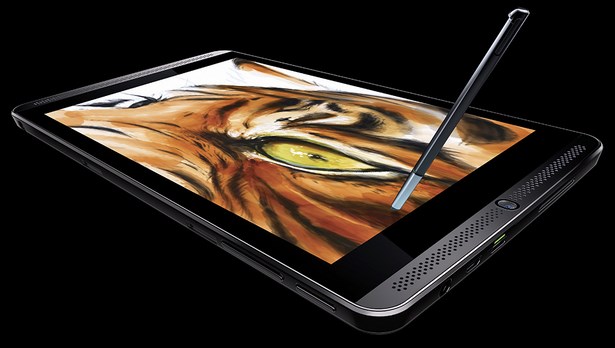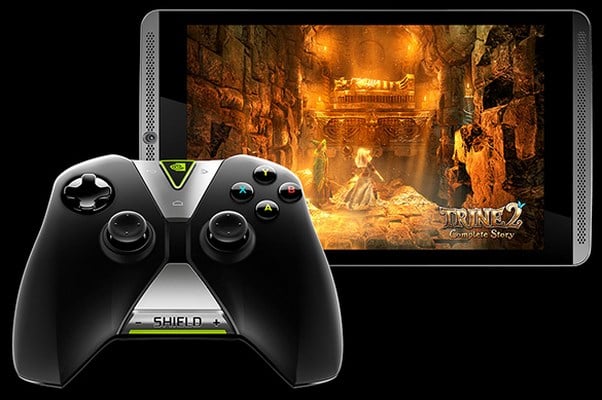NVIDIA Debuts SHIELD Tablet and Wireless Controller
Introducing the SHIELD Tablet
NVIDIA just officially announced the SHIELD tablet (powered by their Tegra K1 SoC) and SHIELD wireless controller. As the SHIELD branding implies, the new SHIELD tablet and wireless controller builds upon the previously-released, Android-based SHIELD portable to bring a true gaming-oriented tablet to consumers. In some ways, the SHIELD tablet and wireless controller are somewhat of mashup of the SHIELD portable and the Tegra Note 7, but featuring newer, updated technology and better materials. You could think of the SHIELD tablet and wireless controller as an upgraded SHIELD portable device, with the screen de-coupled from the controller.
The original SHIELD portable and the Tegra Note 7, were built around NVIDIA’s Tegra 4 processor. The SHIELD tablet, however, is powered by the newer Tegra K1, which features quad ARM A15 cores and 192 Kepler-class graphics cores. Take a look at the SHIELD tablet’s full list of specifications in the table below, sit back and take in our hands-on preview of the device and then we’ll talk a bit about some the SHIELD Tablet's more interesting features…

NVIDIA SHIELD Tablet with Stylus
|

As you can see, the SHIELD tablet’s specifications read like some of the more powerful tablets currently on the market. The device features the aforementioned NVIDIA Tegra K1 SoC, paired to 2GB of RAM and an 8”, full-HD IPS display, with a native resolution of 1920x1200. There are also a pair of 5MP cameras on the SHIELD tablet (front and rear), 802.11a/b/g/n 2x2 MIMO WiFi configuration, GPS, a 9-axis motion sensor, and Bluetooth 4.0 LE. In addition to the WiFi-only version (which features 16GB of internal storage), NVIDIA has a 32GB version coming with LTE connectivity as well. NVIDIA hasn’t announced which wireless carriers they’ll be partnering with, but the LTE bands supported are compatible with AT&T and T-Mobile.

SHIELD tablet and SHIELD wireless controller
The software on the SHIELD tablet is reminiscent of the SHIELD portable as well. NVIDIA is using a mostly untouched version of Android on the SHIELD tablet. The only additions made to the OS are a few pre-installed applications, and control panels for the SHIELD’s gaming features. The SHIELD tablet will also be receiving regular OTA updates directly from NVIDIA, in the same way the SHIELD portable and Tegra Note 7 have. NVIDIA should actually get a lot of credit in this regard; the company has been regularly releasing new ROMs for the devices, that not only update the OS, but add new features and capabilities.

Frostbyte's Trine 2 is included on the SHIELD tablet
Some of those new features include the ability to stream games directly to Twitch, NVIDIA’s ShadowPlay technology, PC Streaming, NVIDIA GRID cloud gaming support, and access to the new SHIELD hub. The SHIELD tablet is also one of a select few mobile devices that’s been certified to stream Netflix 1080p content. We should also mention that NVIDIA is including a copy of the game Trine 2 with the SHIELD tablet, as well as a copy of an in-house developed app called Dabbler. Dabbler is a GPU-accelerated drawing / imaging apps that leverages NVIDIA DirectStylus 2 technology as well. DirectStylus 2 uses the Tegra K1’s image processing capabilities to analyze data from the device’s touch sensor to discern the difference between a fine-tip stylus, finger, eraser and palm input, eliminating the need for a separate digitizing layer for the screen to support a stylus. DirectStylus 2 is also intelligent enough to discern pressure, so the included blade-tipped stylus can be used to draw fine or thick lines, or when turned over it can act like an eraser. DirectStylus 2 is similar to the original version, employed in the Tegra Note 7, but the latest version benefits from the increased horsepower of K1, in addition to some modified and improved algorithms.

NVIDIA SHIELD tablet break-out
The physical design of the SHIELD tablet is reminiscent of many other slates currently on the market, but NVIDIA has incorporated a number of gamer-friendly features. For example, the SHIELD tablet has front-facing speakers, with a dual-ported bass reflex enclosure. The output from the speakers can get surprisingly loud, and it sounds surprisingly “full”, despite the relatively small size of the speakers themselves. The magnesium frame of the SHIELD tablet is also very rigid and features an integrated thermal shield. There is also a built-in port for the included stylus, and the optional smart-cover can be used as a stand, with support for three positions.






